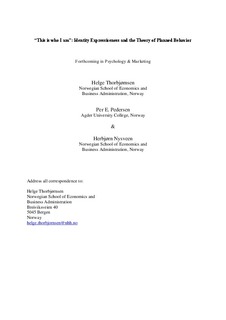| dc.contributor.author | Thorbjørnsen, Helge | |
| dc.contributor.author | Pedersen, Per Egil | |
| dc.contributor.author | Nysveen, Herbjørn | |
| dc.date.accessioned | 2015-05-08T10:51:20Z | |
| dc.date.accessioned | 2015-09-22T08:33:38Z | |
| dc.date.available | 2015-05-08T10:51:20Z | |
| dc.date.available | 2015-09-22T08:33:38Z | |
| dc.date.issued | 2007 | |
| dc.identifier.citation | Psychology & Marketing 2007, 24(9):763-785 | nb_NO |
| dc.identifier.issn | 1520-6793 | |
| dc.identifier.uri | http://hdl.handle.net/11250/301036 | |
| dc.description | - Peer reviewed | nb_NO |
| dc.description.abstract | This paper explores the role of self-identity expressiveness and social identity expressiveness in the context of Multimedia Messaging (MMS) adoption. An extended version of the Theory of Planned Behavior (TPB) including a wider array of identity and social influences is developed and tested. As hypothesized, self-identity expressiveness and social identity expressiveness prove to be significant determinants of intentions to use. Moreover, the extended TPB model explains 62% of the variance in usage intentions. The paper also investigates the relationship between self identity expressiveness and attitude and between social identity expressiveness and subjective norm. The study results indicate that the concept of subjective norm alone is insufficient to capture the rich universe of identity and social influences driving behavioral intentions. Implications for marketing managers and scholars are discussed. (c) 2007 Wiley Periodicals, Inc. | nb_NO |
| dc.description.abstract | This paper explores the role of self-identity expressiveness and social identity expressiveness in the context of Multimedia Messaging (MMS) adoption. An extended version of the Theory of Planned Behavior (TPB) including a wider array of identity and social influences is developed and tested. As hypothesized, self-identity expressiveness and social identity expressiveness prove to be significant determinants of intentions to use. Moreover, the extended TPB model explains 62% of the variance in usage intentions. The paper also investigates the relationship between self identity expressiveness and attitude and between social identity expressiveness and subjective norm. The study results indicate that the concept of subjective norm alone is insufficient to capture the rich universe of identity and social influences driving behavioral intentions. Implications for marketing managers and scholars are discussed. (c) 2007 Wiley Periodicals, Inc. | nb_NO |
| dc.language.iso | eng | nb_NO |
| dc.title | "This is who I am": Identity expressiveness and the theory of planned behavior | nb_NO |
| dc.title.alternative | "This is who I am": Identity expressiveness and the theory of planned behavior | nb_NO |
| dc.type | Journal article | nb_NO |
| dc.date.updated | 2015-05-08T10:51:20Z | |
| dc.identifier.cristin | 708932 | |
| dc.subject.keyword | Adopsjon / Adoption | |
| dc.subject.keyword | Mobilteknologi / Mobile | |
| dc.subject.keyword | Normer / Norms | |
